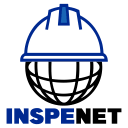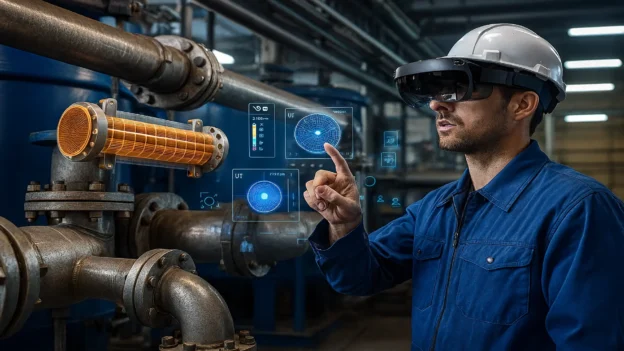Table of Contents
- Technological developments in NDT training
- VR and MR: Differences and synergies in NDT
- Practical VR/MR applications in inspection and training
- Strategic benefits of immersive training
- Technical challenges and considerations
- Convergence with emerging technologies
- Market projection and industrial adoption
- Conclusions
- Referencias
- FAQs about immersive training in NDT
Immersive training in NDT is undergoing an unprecedented transformation in the training of industrial inspection professionals. Traditionally, technical education in Non-Destructive Testing (NDT) relied on physical laboratories, real samples, and direct interaction with equipment and materials. However, the incorporation of immersive technologies such as Virtual Reality (VR) and Mixed Reality (MR) is redefining the way inspectors acquire and apply practical skills.
In an industrial context where safety, efficiency, and traceability are critical factors, the ability to recreate complete inspection environments in a digital space has become a strategic tool for companies, training centers, and certification bodies. These technologies not only optimize learning processes but also raise the standards of quality and reproducibility of immersive training in NDT.
Technological developments in NDT training
For decades, NDT training programs have followed a predominantly classroom-based model, focused on practical repetition under the supervision of certified instructors. Standards such as ASNT SNT-TC-1A, ISO 9712, and API and AWS schemes define the required levels of competence, but their practical application involves high costs for infrastructure, testing materials, and exposure to operational risks.
In this scenario, the digital transformation of the sector has opened up a new field: immersive training, which combines three-dimensional simulation, haptic interaction, and realistic virtual scenarios to reproduce field conditions in controlled and safe environments. Through VR/MR platforms, students can experience ultrasound (UT), radiography (RT and RTR), penetrant testing (PT), magnetic particle testing (MT), or positive material identification (PMI) techniques without using real equipment or exposing materials or people to radiological, electrical, or mechanical risks.
VR and MR: Differences and synergies in NDT
Virtual Reality (VR) completely immerses the user in a computer-generated digital environment, isolating them from the physical world through the use of headsets and controllers. In contrast, Mixed Reality (MR) combines digital elements with the real environment, allowing the operator to see both their physical surroundings and superimposed virtual objects.
In practice, both technologies are integrated to optimize the technical learning process.
- In VR, students can manipulate virtual components of a process plant, perform weld inspections, or analyze ultrasonic signals generated by simulators in real time.
- In MR, they can observe real physical equipment while 3D models of defects, thicknesses, or discontinuities are projected onto its surface, facilitating spatial understanding and technical diagnosis.
This convergence creates a multisensory learning experience, where the user not only observes but actively participates in the process, developing analysis, precision, and decision-making skills in an environment that replicates operational reality.
Practical VR/MR applications in inspection and training
The use of Virtual Reality and Mixed Reality (VR/MR) in NDT has gone from being a technological curiosity to a tool adopted by large companies in the energy, petrochemical, aeronautical, and naval sectors. The most common scenarios include:
a) Ultrasonic inspection (UT) simulators
Using Virtual Reality (VR) platforms, users manipulate virtual probes on 3D surfaces of pipes, welds, or pressure vessels. The system generates echo signals and graphic representations equivalent to those of real equipment. This allows users to practice interpreting indications, calibrating equipment, and evaluating thicknesses without the need for real parts.
b) Industrial radiography training (RT and RTR)
Radiography simulation with gamma sources or X-rays is one of the fields that benefits most. In virtual environments, students can configure exposure parameters, position sources and panels, and observe projection results without radiological risk. Real-time radiography (RTR) simulated in MR allows internal defects to be visualized and their relationship to the geometry of the weld or inspected material to be studied.
c) Penetrant testing (PT) and magnetic particle testing (MT)
VR/MR is used to recreate the stages of cleaning, application, development, and interpretation of discontinuities. These tools improve understanding of the detection mechanisms and the importance of each step in the quality of the result.
d) Integration of PMI and virtual metallurgical analysis
VR/MR tools can incorporate metallographic and chemical composition databases, allowing technicians to perform virtual positive material identification (PMI) and compare alloy readings in real time. This simulation is particularly useful in training for API 510 and API 570 standards, which require accurate identification of materials in pressure equipment and piping.
Strategic benefits of immersive training
Cost and risk reduction
Conventional NDT training requires materials, equipment, consumables, and controlled environments. Immersive simulation eliminates these recurring costs and significantly reduces the risks associated with radiation, handling heavy components, or using chemicals.
Repeatable and measurable learning
VR/MR platforms record every user interaction: inspection time, exploration routes, interpretation errors, or compliance with procedures. This facilitates objective assessment of competence and the development of performance metrics.
Unlimited and replicable scenarios
With virtual reality, instructors can recreate anything from a simple weld bead to an entire process unit with variable environmental conditions, corrosion under insulation (CUI), or simulated structural defects. The same scenario can be used by hundreds of students, ensuring consistency in training.
Visual and experiential learning
Recent studies show that students who learn through immersive simulation retain up to 75% more practical information than those trained using traditional methods alone. Visual, auditory, and kinesthetic interaction strengthens the understanding of complex concepts such as wave propagation, defect geometry, or material attenuation.
Technical challenges and considerations
Although the benefits are significant, the adoption of VR/MR in NDT faces technical and cultural challenges.
- Validation and standardization: Simulators must accurately replicate the physical responses of materials and equipment. ASNT and other organizations are working on regulatory frameworks that will allow these methods to be integrated into certification processes.
- Initial investment: The development of 3D models, simulation software, and haptic devices requires a considerable initial investment, although their cost decreases as their institutional use expands.
- Adoption curve: Not all technicians are familiar with advanced digital tools. Training in the use of the virtual environment is a necessary first step.
- Interoperability: VR/MR systems must be integrated with learning management systems (LMS) and certification databases to provide traceability and competency control.
Convergence with emerging technologies
The evolution does not stop at simulation. The next stage in technical training aims to integrate VR/MR with Artificial Intelligence (AI), Industrial Internet of Things (IIoT), and digital twins.
- Digital twins allow the creation of dynamic virtual replicas of real assets (pipes, tanks, exchangers) that are updated in real time with sensor data.
- AI can evaluate the performance of a virtual inspector, suggest improvements, or detect recurring error patterns.
- The IIoT connects simulations with physical equipment to generate calibration data and predictive analytics.
Together, these technologies form an ecosystem where training, operation, and maintenance converge in the same digital environment, reducing downtime, optimizing inspections, and ensuring asset integrity.
Market projection and industrial adoption
According to recent reports by MarketsandMarkets and Research and Markets, the global market for virtual reality applied to industry is estimated to reach USD 45 billion by 2030, with sustained growth in the inspection, manufacturing, and energy sectors.
Leading inspection and certification companies are already implementing virtual laboratories for NDT training, enabling remote Level I and II certification under digital supervision, especially in post-pandemic environments where mobility and access to plants are limited.
The ASNT, for its part, has recognized the potential of immersive training as a complementary tool in the training of inspectors, promoting collaborative initiatives with technology developers to establish simulator validation criteria.
Conclusions
Immersive NDT training represents a profound change in the technical training of industrial inspectors. Thanks to Virtual Reality (VR) and Mixed Reality (MR) technologies, professionals can experience complex scenarios, practice methods such as UT, RT, PT, or PMI, and make critical decisions without real risks or high costs.
This methodology used in immersive NDT training facilitates the standardization of skills, improves knowledge retention, and allows future advances such as digital twins and Artificial Intelligence to be integrated into training programs. They do not replace field experience, but they are establishing themselves as an essential complement to modern technical learning. They allow real operating conditions to be reproduced, skills to be measured accurately, and knowledge standardization to be guaranteed in a safe, economical, and sustainable environment.
In the coming years, the convergence of VR/MR, AI, and digital twins will transform the way inspectors are trained and certified. Training will no longer be a linear process but will become a dynamic and adaptive experience, where each professional will be able to practice in specific scenarios aligned with the risks and configurations of their plant or facility.
In an industry where integrity, safety, and accuracy are non-negotiable, immersive reality paves the way for a new era of technical training: one where knowledge is no longer transmitted solely in classrooms, but is experienced, interacted with, and mastered within virtual environments that replicate the industrial world with unprecedented realism.
Take your NDT career to the next level with NDT training.
At Inspenet, our courses and diploma programs combine theory, practice, and technology so you can master UT, RT, PT, MT, and PMI safely and effectively.
Referencias
- ASNT. (2016). SNT-TC-1A: Recommended practice for personnel qualification and certification in nondestructive testing (10th ed.). Columbus, OH: American Society for Nondestructive Testing.
- ISO. (2012). ISO 9712: Non-destructive testing — Qualification and certification of NDT personnel (3rd ed.). Geneva: International Organization for Standardization.
- Chen, J., & Wang, X. (2020). Applications of virtual reality and augmented reality in nondestructive testing training. Journal of Nondestructive Evaluation, 39(4), 56.
- Smith, D., & Jones, L. (2019). Immersive learning in industrial inspection: VR/MR applications for NDT training. NDT & E International, 104, 50–60.
FAQs about immersive training in NDT
What is immersive NDT training?
It is technical training using VR/MR to simulate industrial inspections, allowing NDT methods to be practiced without risk and in controlled scenarios.
What NDT techniques can be trained?
Mainly UT, RT/RTR, PT, MT, and PMI, all realistically simulated in virtual environments.
Why is it relevant to the industry?
It allows for the standardization of skills, reduces costs and risks, and prepares inspectors for complex situations that would be difficult to recreate physically.


